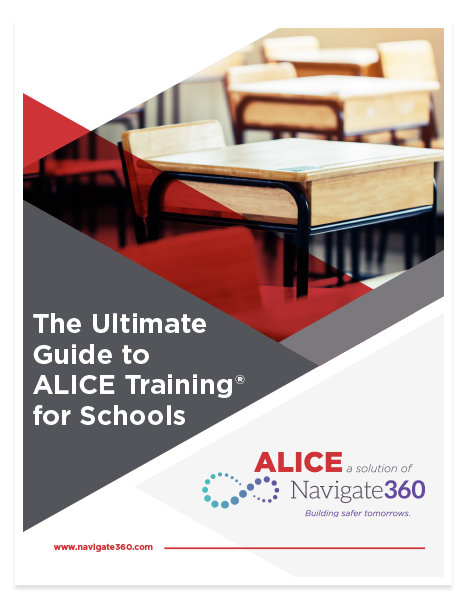The Basics of ALICE Training®
Before delving into what ALICE Training® stands for, it’s important to understand the basics of ALICE. Violence can happen anywhere and at any time. 69% of active shooter incidents last only five minutes or less, often ending before law enforcement arrives. It’s imperative that people know how to respond to an active shooter incident to increase their odds of survival. ALICE Training® empowers people to participate in their own survival until help arrives.
As the industry leader for active shooter response training since 2000, our team of ALICE National Trainers has trained over 18.9 million individuals in ALICE strategies, saving lives and enhancing safety in schools, places of work, and communities across the nation.
ALICE’s multi-option response training program uses a trauma-informed approach and can be used by anyone, anywhere, and at any time.
What Does “ALICE” in ALICE Training® Stand For?
Alert | Lockdown | Inform | Counter | Evacuate
Alert – ‘Alert’ means being aware of your surroundings and is the first sense or notification of danger. Its primary objective is to recognize the signs of an emergency or to receive information about danger from others.
These initial notifications of danger are received by your senses – sight, sound, smell, touch, and taste – as well as through technology – a mobile alert, email, text message, phone call, announcement, and more.
Lockdown – ALICE’s enhanced “Lockdown” strategy is an adaptive and strategic methodology that empowers educators, students, and staff to effectively counteract emergencies in which traditional evacuation may not be effective.
The primary objective of ‘Lockdown’ is twofold: to carve out precious time in the face of danger and to fortify safety measures while awaiting the arrival of law enforcement or the emergence of more opportune avenues such as evacuation.
Inform – ‘Inform’ serves as a key communication strategy, initiated when you receive an alert of danger. Its primary objective is to provide concise, real-time information, enabling individuals to make informed decisions in accordance with their emergency response training, which may involve actions like evacuation or lockdown.
Counter – While ALICE emphasizes the value of utilizing various methods to ensure safety during life-threatening scenarios, Counter is specifically designed as a strategy of last resort. It capitalizes on creating noise, movement, distance, and distraction to minimize the shooter’s ability to accurately target individuals. It is important to note that Counter is not synonymous with fighting; instead, Counter can be defined as any interruption to the intruder’s thought process.
Evacuate – The fundamental aim of Evacuate is to establish physical distance between potential victims and armed intruders. When feasible and safe, the best response is to run from danger, even utilizing non-traditional exits if necessary.
The effectiveness of Evacuate relies on situational awareness and timely evaluation of the best response option. If the available information suggests that evacuation is a safe option, individuals should move to a designated rally point as safely as possible. It’s crucial to establish and practice meeting at rally points during active shooter drills for seamless emergency response.
ALICE Training® is not designed to be sequential nor is it meant to be a checklist. ALICE Training® is a list of options that can be used to stay safe in the event of a violent intruder.
Equip Your Community for the Unthinkable with ALICE Training®
You can’t know if or when an emergency will occur, but you can benefit from the peace of mind found in knowing that you have taken steps to prepare. In the event of an active shooter, the minutes that pass while people are waiting for police to respond are crucial.
ALICE enhances individuals’ ability to make informed decisions, remain calm under pressure, and work together to minimize harm during a crisis.
Download our Ultimate Guide to ALICE Training® for Schools today.





